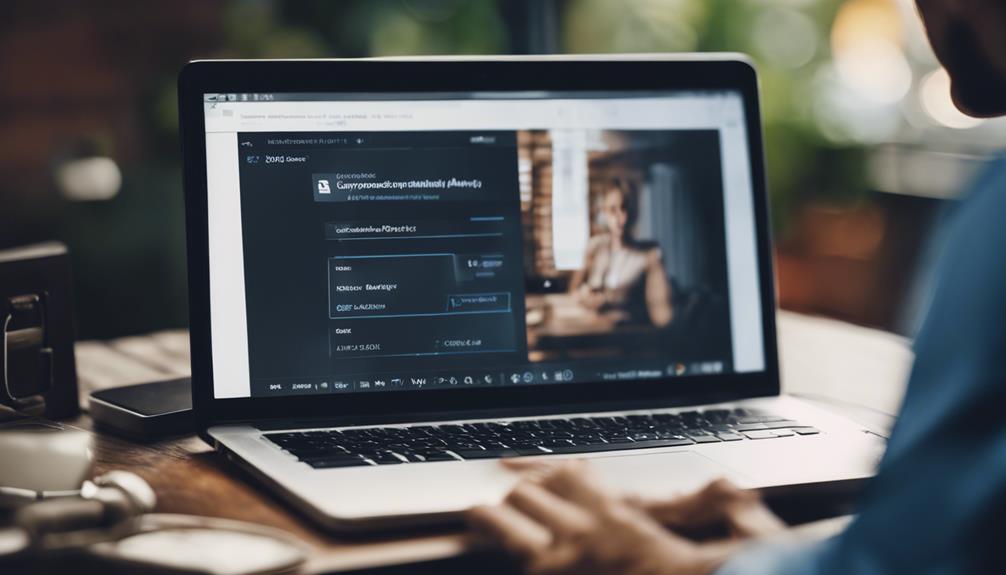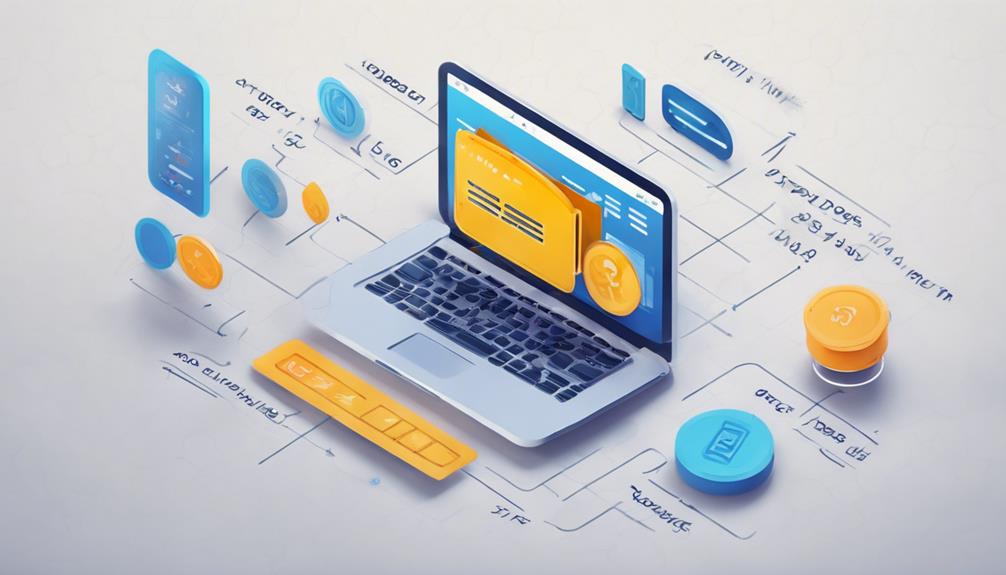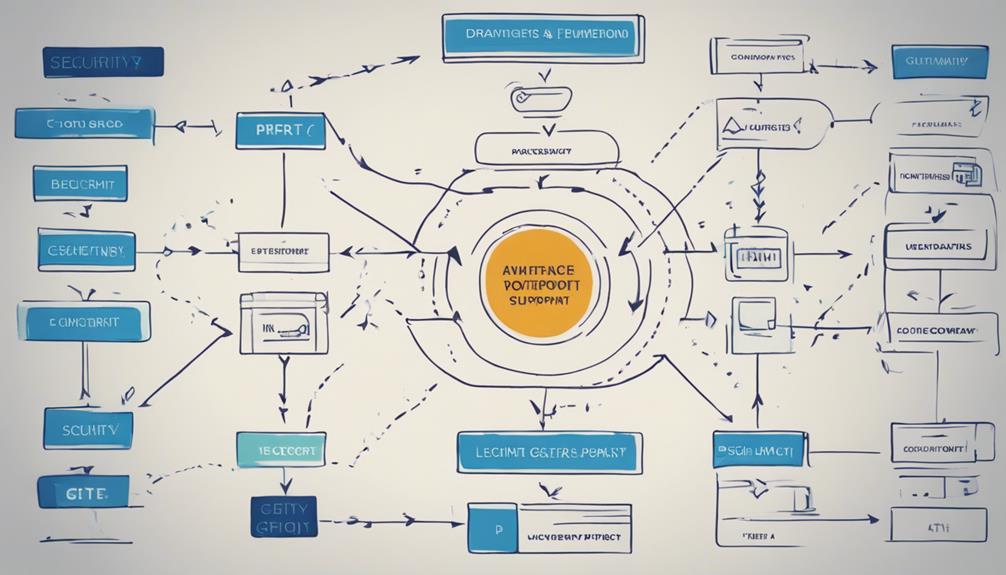To build your own payment gateway: Research thoroughly to recognize market demands. Develop infrastructure for efficient transactions. Choose a compatible payment processor with clear fee structures. Focus on security using encryption protocols and fraud detection. Integrate with financial institutions following data protection standards. Design a user-friendly interface with easy navigation. Conduct rigorous testing for performance and security. Deploy the system confidently after thorough testing. Maintain by updating security standards and monitoring performance. Continuously improve based on feedback and industry trends. Each step is essential for a successful payment gateway.
Key Takeaways
- Research market demand, identify target audience, and plan technical requirements.
- Establish secure infrastructure, adhere to compliance, and support various payment methods.
- Select compatible payment processor with transparent pricing, security features, and scalability.
- Ensure data security with encryption, tokenization, fraud detection, and regular audits.
- Integrate with financial institutions, comply with regulations, and focus on user-friendly interface design.
Research and Planning

To kick off your journey towards building your own payment gateway, begin by conducting thorough research and meticulous planning. Understanding the demand for custom payment solutions in the market is vital. Analyze existing payment gateway offerings to identify gaps and opportunities that your custom payment gateway can address. Define your target audience and their specific payment processing needs to tailor your solution effectively. Plan the technical requirements and features of your custom payment gateway to make sure it meets the standards of security, compliance, and user interface expectations.
When delving into the development of your payment gateway, consider aspects such as PCI DSS compliance, which is essential for handling secure online transactions. Collaborating with financial institutions may be necessary to facilitate transaction processing smoothly. Estimating the development timeline and budget is key to managing the project efficiently. By focusing on research and planning at this stage, you lay a solid foundation for the successful creation of your custom payment gateway.
Building Infrastructure

When moving towards constructing the infrastructure for your custom payment gateway, focus on establishing the foundation necessary for efficient transaction handling. Infrastructure development is essential for the seamless operation of your payment gateway.
This involves setting up secure servers, robust databases, and configuring networks to guarantee the safe processing of transactions. Scalability and redundancy measures are key to handle increasing transaction volumes and maintain uninterrupted service.
Your infrastructure design must adhere to industry standards and compliance regulations to ensure security and reliability for users. Building a robust infrastructure is critical for supporting various payment methods, currencies, and transaction types effectively.
Selecting Payment Processor

When choosing a payment processor, focus on aspects like compatibility with your system and the fee structures available. Consider the range of payment methods and currencies supported by the processor to make certain it aligns with your business needs.
Evaluating these factors will help you make an informed decision on selecting the right payment processor for your payment gateway.
Processor Compatibility
Considering compatibility between your business model and target market is crucial when selecting a payment processor. Evaluate if the payment processor supports various payment methods such as credit cards, digital wallets, and bank transfers.
Look for competitive transaction fees and transparent pricing structures to optimize cost-effectiveness. Confirm the payment processor has robust security features, complies with industry standards like PCI DSS, and is known for reliable payment processing.
Assess the scalability and flexibility of the payment processor to adapt to your business growth and changing payment processing requirements. By choosing a payment processor that aligns with your business needs and customer preferences, you can establish a solid foundation for seamless transactions and customer satisfaction.
Fee Structure Options
To effectively choose a payment processor for your business, understanding the different fee structure options available is key. Payment processors typically charge transaction fees between 1.5% to 3.5% per transaction, impacting your overall processing costs to a large extent.
Some processors offer flat-rate pricing models, such as Square's 2.6% + 10 cents per transaction, simplifying fee structures for easier budgeting. Businesses like Stripe and PayPal, with transparent pricing and no setup or monthly fees, are popular choices. However, high-risk businesses might encounter higher processing fees due to increased chargeback risks and regulatory challenges.
Factors like transaction volume, average ticket size, industry type, and regulatory hurdles can all influence the fee structures offered by payment processors.
Ensuring Security Measures

For guaranteeing robust security for your payment gateway, implementing encryption protocols like SSL/TLS is essential. Secure payment data during transmission by encrypting it with these protocols.
Utilize tokenization to enhance security further by replacing sensitive card information with tokens, reducing the risk of data breaches.
Implement fraud detection tools to monitor and prevent fraudulent transactions, ensuring compliance with industry standards such as PCI DSS.
Conduct regular security audits and penetration testing to identify and address vulnerabilities proactively.
By adhering to these security measures, you can establish a foundation of robust security for your payment gateway, safeguarding sensitive information and maintaining trust with your customers.
Stay vigilant in upholding these security practices to mitigate risks and protect your platform from potential threats.
Invest in the necessary resources to maintain a secure payment environment that meets the highest security standards in the industry.
Integrating With Financial Institutions

To successfully integrate with financial institutions, you need to establish connections with acquiring banks and payment processors through bank API integration. Guarantee compliance by collaborating with these institutions to meet industry regulations and standards, and implement security protocols approved for data protection.
Bank API Integration
Integrating your payment gateway with bank APIs streamlines transaction processing and enhances security through real-time communication with financial institutions.
To successfully integrate with bank APIs, follow these steps:
- Connect your payment gateway to financial institutions' APIs for seamless transaction processing.
- Enable real-time communication between your gateway and banks for secure fund transfers and transaction verifications.
- Guarantee compliance with banking regulations by integrating with multiple banks to access services like account verification and transaction history retrieval.
This integration enhances the reliability, scalability, and global reach of your payment gateway solution.
Compliance Requirements Check
Guarantee compliance with the necessary regulations and standards when integrating your payment gateway with financial institutions.
To guarantee a compliant payment gateway, adhere to the Payment Card Industry Data Security Standard (PCI DSS) for secure online transactions.
Establish relationships with acquiring banks to enable smooth transaction processing for businesses.
Integrate with reputable card networks such as Visa and Mastercard for authorization and settlement of transactions.
Verify all legal requirements and regulations pertinent to operating a payment gateway to safeguard financial data processing.
Implement anti-money laundering (AML) and Know Your Customer (KYC) protocols to enhance the security and integrity of financial transactions through your payment gateway.
Security Protocols Implementation
Guarantee the implementation of robust security protocols for seamless integration with financial institutions to safeguard payment transactions.
When integrating your payment gateway with financial institutions, consider the following:
- Encryption: Utilize encryption to protect sensitive payment data during transmission.
- Compliance: Assure compliance with industry regulations such as PCI DSS to maintain data security.
- Authentication Mechanisms: Implement proper authentication mechanisms to verify transactions and prevent fraudulent activities.
Developing User-Friendly Interface

Developing a user-friendly interface is essential for maximizing customer satisfaction and driving conversion rates in your payment gateway. To achieve this, focus on user-friendly interface design that enhances the overall customer experience.
Incorporate intuitive navigation and clear call-to-action buttons to improve usability. Utilize responsive design to guarantee seamless access on various devices. Implement visual hierarchy and consistent branding elements to enhance brand recognition and trust.
Conduct usability testing and gather feedback to refine the interface for best user satisfaction. By prioritizing these elements, you can create a payment gateway that not only meets but exceeds user expectations.
Rigorous Testing

To guarantee the smooth operation of your payment gateway, rigorous testing is imperative to validate its functionality under various conditions. Here are three essential aspects to take into account during the testing phase:
- Transaction Scenarios: Simulating a wide range of transaction scenarios is vital to identify and address any potential issues that may arise during real-world usage. This testing ensures that your payment gateway can handle different types of transactions efficiently and securely.
- Performance Testing: Conducting performance testing is essential to assess how your payment gateway performs under various loads. This testing helps determine the gateway's speed, responsiveness, and overall reliability, ensuring it can handle peak transaction volumes without compromising on performance.
- Security Testing: Checking for vulnerabilities and ensuring compliance with industry standards is a critical part of the testing process. Security testing helps identify and address any potential weaknesses in the payment gateway, safeguarding sensitive user data and providing a secure transaction environment.
Deployment and Maintenance

Deployment and Maintenance of your payment gateway system are essential steps in ensuring its continued effectiveness and security. Deployment involves launching the system for live transactions after thorough testing and certification. Maintenance includes updating the gateway to meet security standards, compliance regulations, and technology advancements. Ongoing monitoring is important to guarantee peak performance, security, and reliability for uninterrupted transaction processing.
Regular maintenance tasks may involve troubleshooting issues, applying security patches, and enhancing functionalities based on user feedback. Audits and updates are necessary to keep the system efficient, secure, and compliant with industry standards. As technology evolves, staying updated with the latest security measures is crucial.
Ongoing Updates and Maintenance

How can you guarantee the ongoing effectiveness and security of your payment gateway system through consistent updates and maintenance practices? Ensuring your payment gateway remains compliant with changing regulations and up-to-date with security standards is vital. Here are three key practices to ponder:
- Regular Maintenance: Monitor system performance, resolve technical issues promptly, and update software components to keep your payment gateway running smoothly.
- Security Updates: Implement security patches and feature enhancements regularly to protect your system against evolving cyber threats and vulnerabilities.
- Enhancing User Experience: Provide ongoing customer support to address inquiries, troubleshoot payment issues, and improve the overall user experience. Continuous improvement based on user feedback and industry trends is essential to stay competitive in the payment gateway market.
Frequently Asked Questions
Can I Create My Own Payment Gateway?
Yes, you can create your own payment gateway. It involves planning for compliance, security, and technical requirements. By developing a custom gateway, you gain control, save costs, and access global markets.
Challenges like compliance, security, and maintenance may arise, but careful market research, design, development, testing, and compliance measures can help overcome them. Custom gateways suit businesses with specific needs, despite time, cost, and regulatory obstacles.
What Are the Steps of Payment Gateway?
To build a payment gateway, you must:
- Research the market
- Design secure infrastructure
- Partner with banks
- Integrate payment methods
- Test thoroughly
This process guarantees smooth and secure transactions. By following these steps, you can create a reliable payment gateway that meets industry standards and customer needs.
How Do I Start My Own Payment Processing?
To initiate your payment processing, it is essential to research market demand, competition, and legal requirements. Establish partnerships with banks and processors, and develop a secure, user-friendly payment gateway infrastructure. Test rigorously for reliability and security.
Your path to success involves understanding the market, compliance, partnerships, infrastructure development, and testing. By following these steps, you can commence building your payment processing solution effectively.
How Do I Become a Payment Gateway Company?
To become a payment gateway company, you need to fulfill regulatory requirements, build relationships with banks and processors, prioritize security, scale infrastructure, and offer reliable support.
For instance, establishing partnerships with banks like XYZ Bank can streamline transaction processing. Remember, compliance, security, and scalability are key pillars for success in this industry.
Maintaining these aspects will help you establish a reputable payment gateway service.
Conclusion
To wrap up, by following this step-by-step guide to building your own payment gateway, you can create a secure and efficient system for processing online transactions.
Research, planning, infrastructure building, selecting a payment processor, guaranteeing security measures, integrating with financial institutions, developing a user-friendly interface, rigorous testing, deployment, and ongoing maintenance are key components to take into account.
Keep these steps in mind as you start on this project to guarantee a successful and reliable payment gateway for your business.










